Newsletter: Painter Ariana Papademetropoulos takes us into esoteric worlds at Deitch
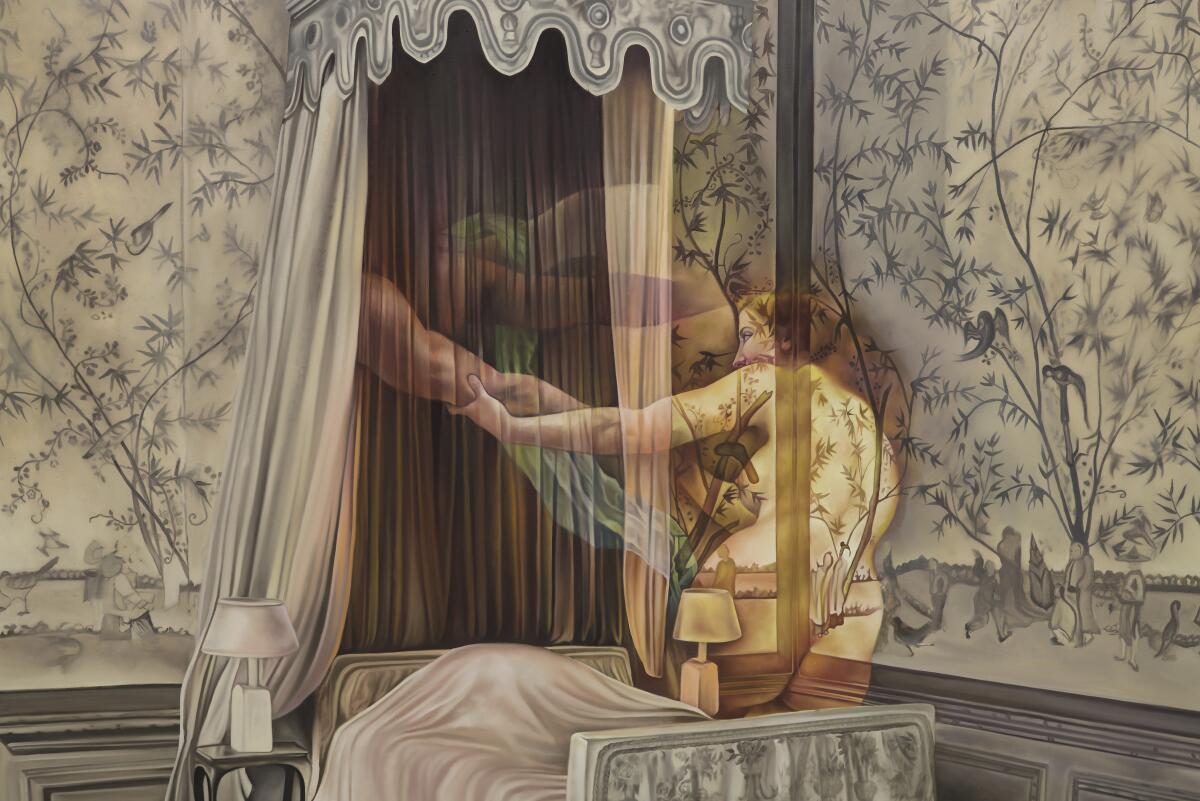
- Share via
It’s fall and I’m all about native-plant shopping. I’m Carolina A. Miranda, arts and urban design columnist at the Los Angeles Times, with your weekly essential arts newsletter — and telenovela sci-fi:
Alchemical art
Sometimes the internet can be a magical thing. For about a year, I’ve used an extension developed by the Art Institute of Chicago in Google Chrome that shows a new piece of art from the museum’s collection every time I open a new browser window. It’s a good way to see obscure stuff buried deep in the collection, such as unfinished drawings or a pre-Columbian amulet from Peru.
Last week, I turned up a set of mid-19th century witch balls, the hollow glass spheres used to ward off or trap troublesome spirits; they’re also employed as a tool of divination, most commonly in England and in the United States. The object — delicate, translucent glass striated with threads of white — stopped me in my tracks. It also sent me down a bit of an internet rabbit hole. I found out that New York’s Metropolitan Museum of Art has witch balls in its collection, as does the Fine Arts Museums of San Francisco.
It made me wonder what other tools of magic were hidden in museum collections and what it meant to gaze into an orb and find within its contours a portal to other worlds.
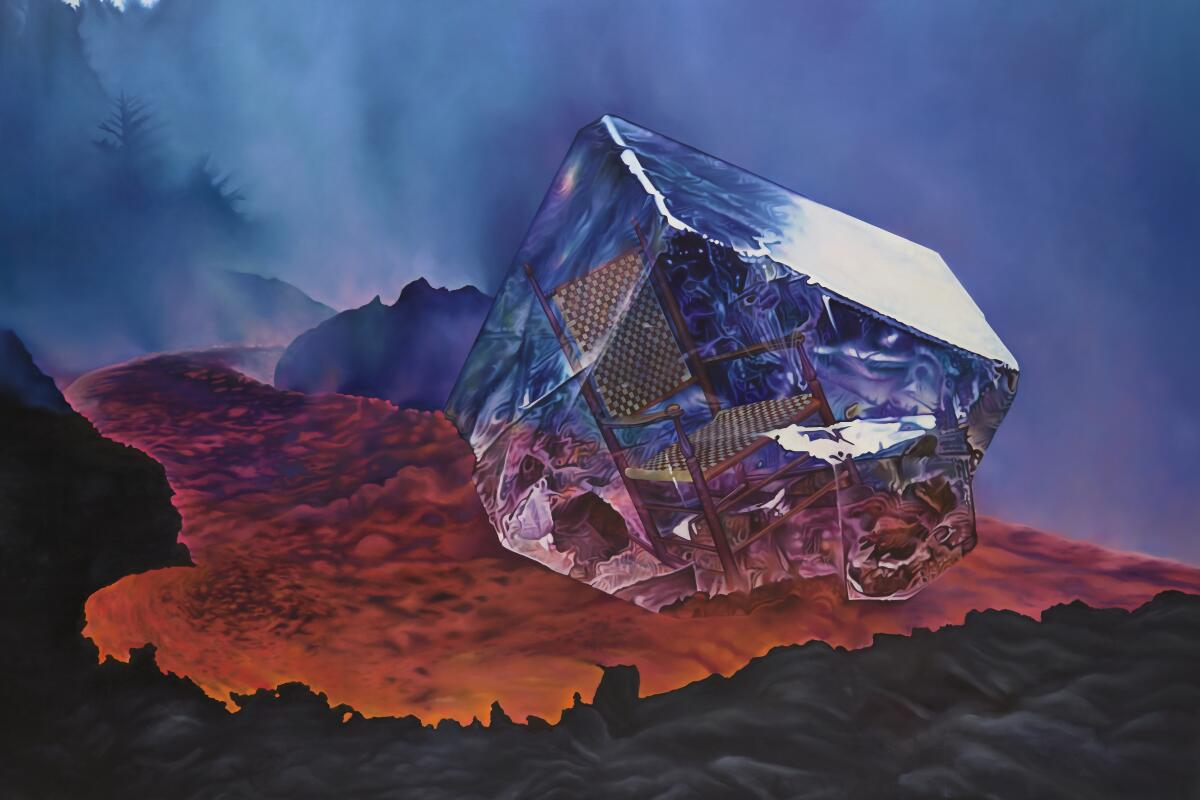
All of this had me in just the right mindset as I wandered into Ariana Papademetropoulos’ exhibition at Jeffrey Deitch the next day.
Her show “The Emerald Tablet,” which is on view through next week, consists of two parts. In one gallery, Papademetropoulos presents six new, large-scale oil paintings that seem to embody the idea of bewitched worlds within worlds: In one canvas, a troupe of ghostly spirits frolics in a Victorian bedroom; in another, a delicate bubble containing a cosmic world floats perilously over a rocky landscape. In the rest of the gallery’s voluminous space, Papademetropoulos has organized a group exhibition that brings together works by artists she is inspired by and whose works reverberate with esoteric themes.
“They all had metamorphosis in common,” she says of the works in the show, “and that is alchemy.”
“And in terms of alchemy, I was thinking about worlds within worlds, or bubbles within a painting or the object inside a crystal,” she adds. “There is a theme within the show about vessels and transformations happening within a vessel.”
Make the most of L.A.
Get our guide to events and happenings in the SoCal arts scene. In your inbox once a week.
You may occasionally receive promotional content from the Los Angeles Times.
The idea, she says, was to create a journey. “I thought of my paintings as the beginning of this journey,” she explains via telephone. “And all of the paintings that followed are meant to be portals.”
Those portals include a riotous and eclectic collection of work. A functioning carousel by artist Raúl de Nieves features an assortment of monstrous and fantastic figures riding slowly in circles. A sculpture by Isabelle Albuquerque depicts the body of a woman in the process of becoming feline. A pair of works by Henry Darger shows little girl fairies. Times and styles are compressed for a show that feels rather ageless and otherworldly.
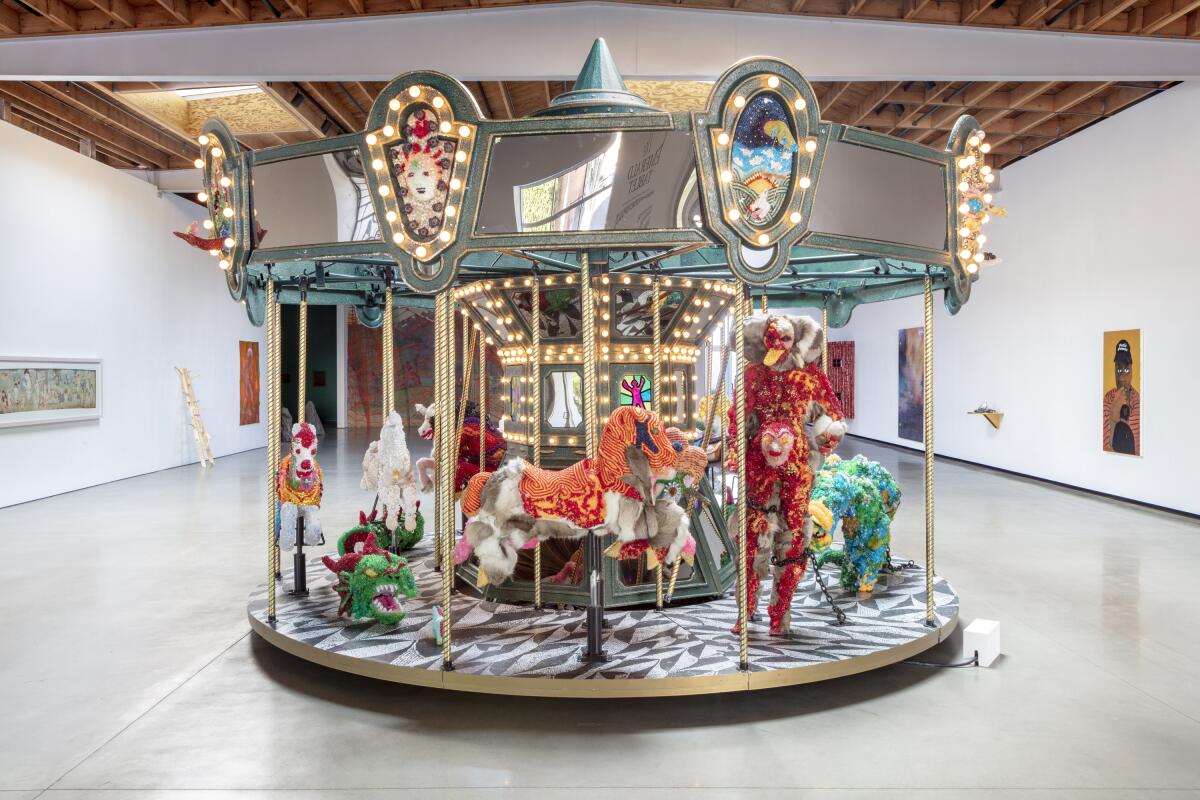
The show, interestingly, ends up feeling very Los Angeles. By choosing alchemy as a theme, “The Emerald Tablet” embraces the occult and alternative spiritual practices that have long found fertile ground in the city. Featured in the show, for example, is the work of 20th century actress and occultist painter Marjorie Cameron — known simply as Cameron — who was quite famously married to fellow occultist and Caltech rocket scientist Jack Parsons.
Theosophy, a mystic practice that had a following among many artists in the early 20th century, also plays a role. Well represented in the show, for example, is Agnes Pelton, a SoCal spiritualist painter who had been interested in theosophy early in her life (and who was recently the subject of a terrific exhibition at the Palm Springs Art Museum).
Papademetropoulos, who grew up in Pasadena, first learned about theosophy after finding a book on the subject at the now-defunct Cliff’s Books when she was 16. Her show’s concept and title echo the work of a prominent adherent: L. Frank Baum, the children’s book author who penned “The Wizard of Oz,” a story centered on a journey to an idyllic Emerald City, which is thought to allude to the Emerald Tablet of Hermes, a key alchemical text.
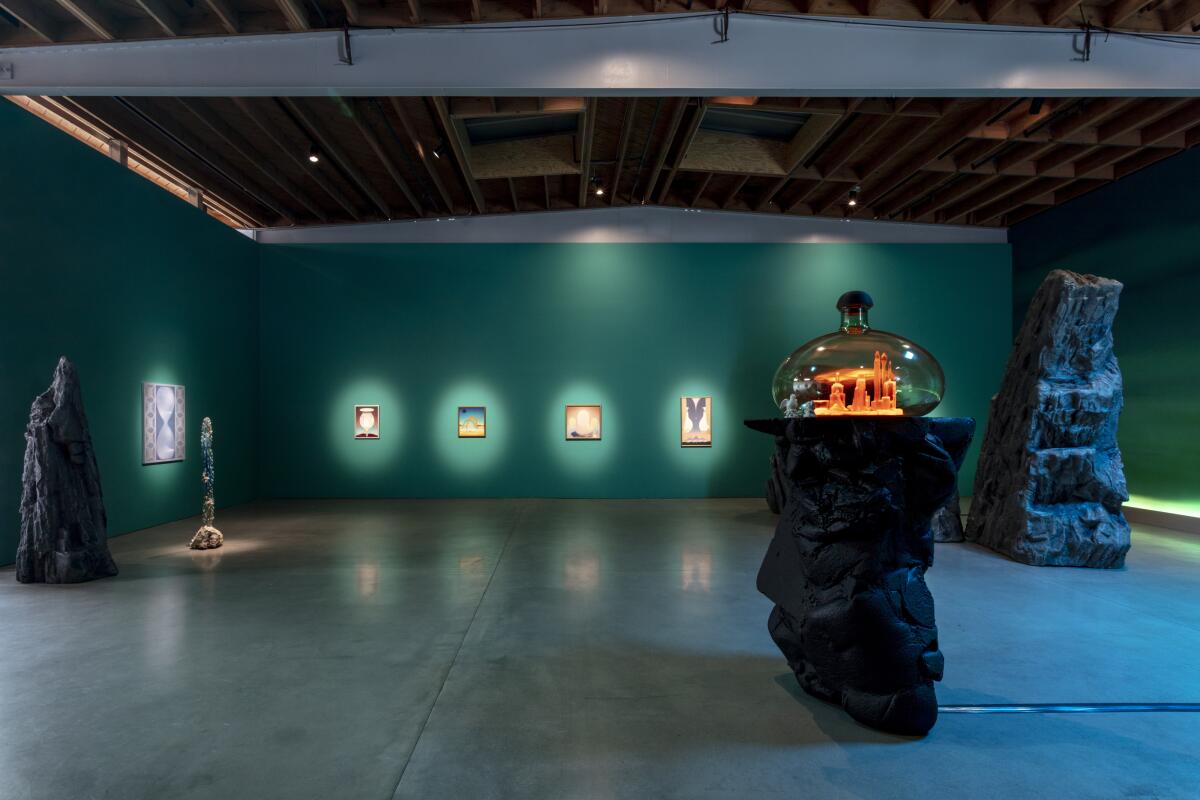
“I wasn’t trying to curate a show about L.A.,” says Papademetropoulos. But it ended up working out that way. “I was interested in fantasy and reality, and L.A. is a place where cults are formed and spiritualities are established.”
Which is what the path through the gallery will ultimately reveal — exalted states from different times, all coming together in the end in a brilliant, emerald space.
Ariana Papademetropoulos, “The Emerald Tablet, a Solo Exhibition and Curatorial Project,” at Jeffrey Deitch. On view through Oct. 23; deitch.com.
Classical notes
“We counted the 470-something days, hours, seconds, and here we are.” That’s what Gustavo Dudamel told the audience assembled at Walt Disney Concert Hall for the first L.A. Phil concert at the site since March 8, 2020. The show featured compositions by Gabriela Ortiz and Tchaikovsky, as well as a performance by Cynthia Erivo, who sang Leonard Bernstein’s “Somewhere.” “The atmosphere,” writes Times classical music critic Mark Swed, “was, of course, energized by loyal audience excitedly back in its beloved concert hall.”
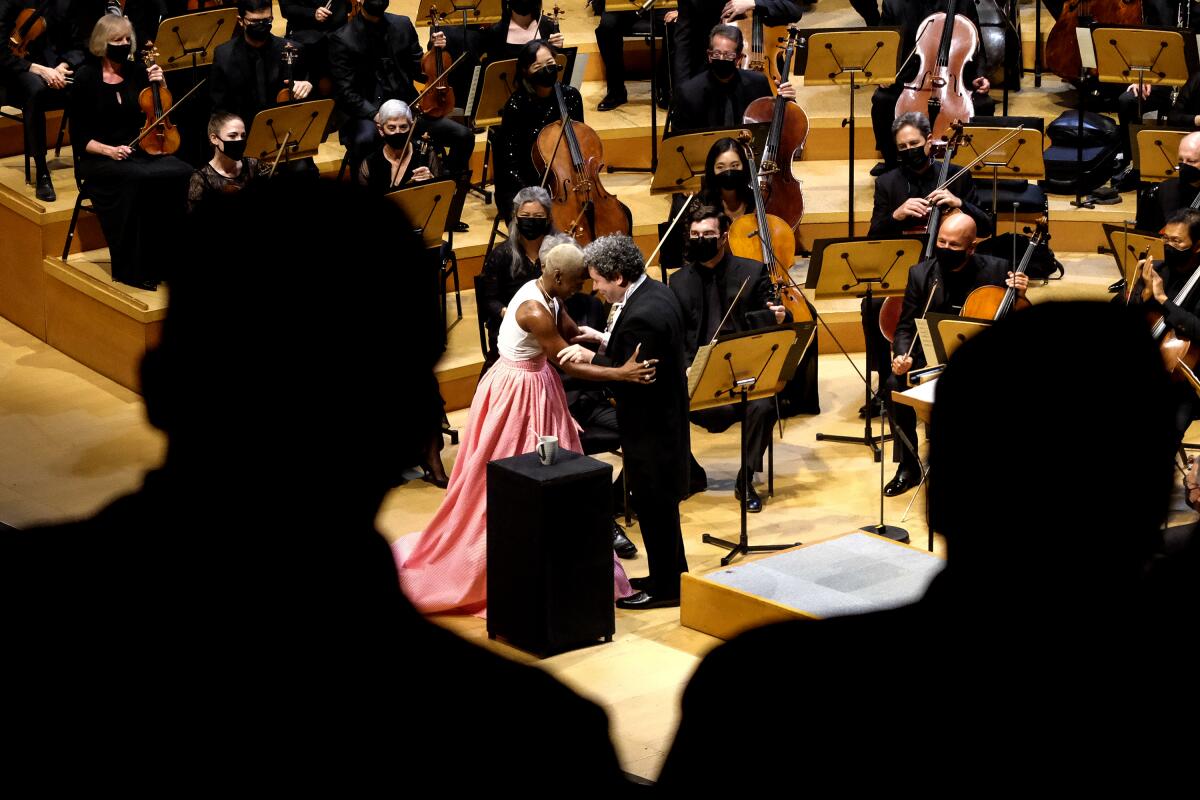
What does it take to tour the U.S. as a foreign musician in the era of COVID-19? A lot of patience and the ability to chase down visa appointments at U.S. embassies all over Europe. That has been the experience of the Danish String Quartet, reports Jessica Gelt, which somehow made it through the bureaucracy in order to kick off a U.S. tour that includes stops in Seattle, Santa Barbara and Santa Monica. After two years of pandemic closures, the group is happy to be back on the road, says violinist Frederik Øland. “It was incredible sitting on the stage.”
Off the stage
The Center Theatre Group recently made headlines for announcing its 2021-22 season, a lineup that featured work by only one female writer. That led playwright Jeremy O. Harris to threaten to pull his acclaimed “Slave Play” from the season. Now, reports Jessica Gelt, CTG has committed its entire 2022-23 season at the Mark Taper Forum to plays written by women-identifying or nonbinary playwrights — a majority of whom will be people of color.
Enjoying this newsletter? Consider subscribing to the Los Angeles Times
Your support helps us deliver the news that matters most. Become a subscriber.
Suni Reid, a performer who has appeared in various “Hamilton” productions since 2017, has filed a complaint with civil rights authorities alleging discrimination, reports Ashley Lee. The Black, transgender cast member had requested a gender-neutral dressing space, alleging harassment in the spaces reserved for male performers. A spokesperson for the show denied the allegations.
On the stage
The Broadway diva Jennifer Holliday performed at the Wallis last week in a show that featured her biggest hit, “And I Am Telling You I’m Not Going” from “Dreamgirls.” Even though the singer flubbed a few lyrics, the concert, writes theater critic Charles McNulty, was nonetheless “intimate and electrifying.”
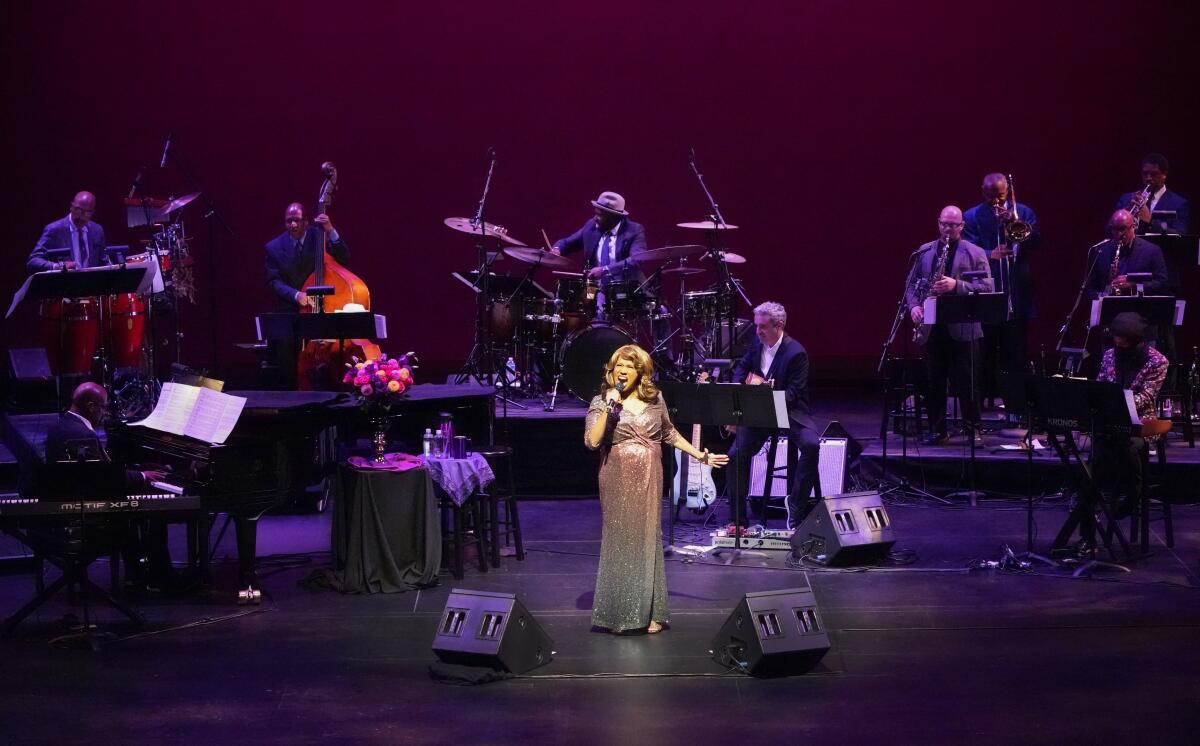
McNulty also reviews Richard Greenberg’s “A Shot Rang Out” in its world premiere at South Coast Rep. The one-man play was written for SCR’s artistic director, David Ivers, to perform — whether virtually or, as now, live. Directed by Tony Taccone, the play “has exquisite prose cadences, droll semantic distinctions and finely observed cultural and psychological insights,” writes McNulty. But the “archness of Ivers’ portrayal” holds the work back.
Halloween is upon is — as are various SoCal scare experiences. Our games critic, Todd Martens, reports on two of the more intriguing frights: “Delusion,” an interactive horror play staged at a historic Pomona mansion, and “Creep LA” at Three of Clubs, a Hollywood bar. These are not the fright fests of yore. “Forget the abundance of jump scares that populate the high-thoroughfare horror mazes of Southern California theme parks and instead revel in the entertainment of watching an actor crawl up from a grave covered in dirt,” writes Martens. “Or enjoy a surprisingly calm chat with a murdered, bookish husband who still longs for the woman who slaughtered him.”
Art report
For 40 years, a mural of abstracted shapes and brilliant geometric patterns on the Watts Towers Arts Center Campus building has greeted visitors to the site. But over the years, the mural, by Alonzo Davis, a co-founder of the pioneering Brockman Gallery, had faded, its forms barely recognizable. That is no longer the case, reports The Times’ Deborah Vankin. Led by Davis, who raised $15,000 for its restoration, a multigenerational team of artists is now bringing it back to life.
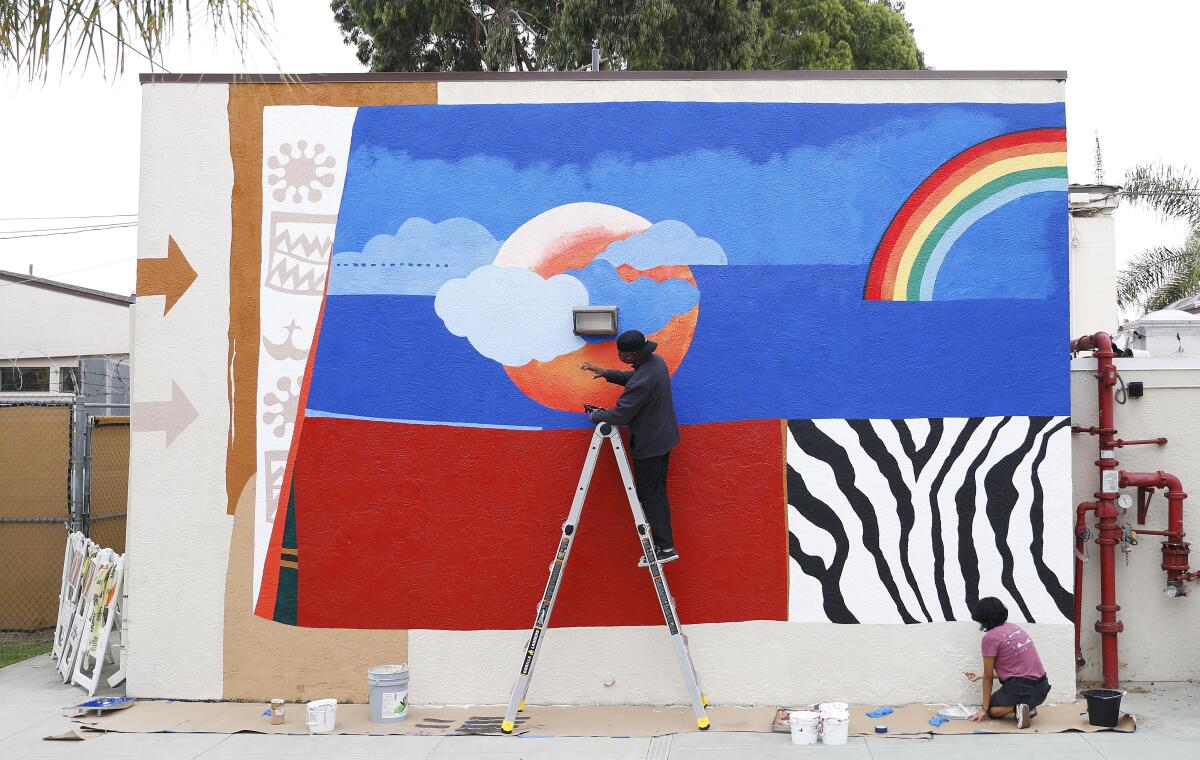
Plus, the art installations for Destination Crenshaw are moving forward. This week, a city commission greenlighted plans for seven permanent art installations by artists such as Brenna Youngblood, Kehinde Wiley, Maren Hassinger and Alison Saar. Fundraising for the $100-million project now stands at $61.5 million, and the Getty Foundation is providing $3 million for the artist commissions, fabrication and conservation.
For years, Los Angeles artist Joel Tauber tracked the life of a tree surrounded by an ocean of tarmac in Parking Lot K at the Rose Bowl in Pasadena. In 2019, the tree was chopped down. This month, the artist held a ceremony for the tree, which he has rendered in a ghostly blue form on the parking lot’s surface. The tree’s legacy will survive as art — but also in the form of other trees. Tauber took seeds and planted them in other locations around Southern California.
The Indigenous landscape
Monday was Indigenous Peoples’ Day, and my colleague Julia Wick wrote about how L.A. is becoming increasingly attentive to the Indigenous history it has erased. As part of that, Father Serra Park, where a statue of the Spanish missionary was toppled last year, will be renamed.
Plus, the plinth that once held the sculpture of Junipero Serra now stands empty, but you can view a virtual monument inspired by Indigenous themes by Joel Garcia and Meztli Projects via augmented reality by downloading the 4th Wall app. The work is one of several virtual projects around Los Angeles organized by Oxy Arts.
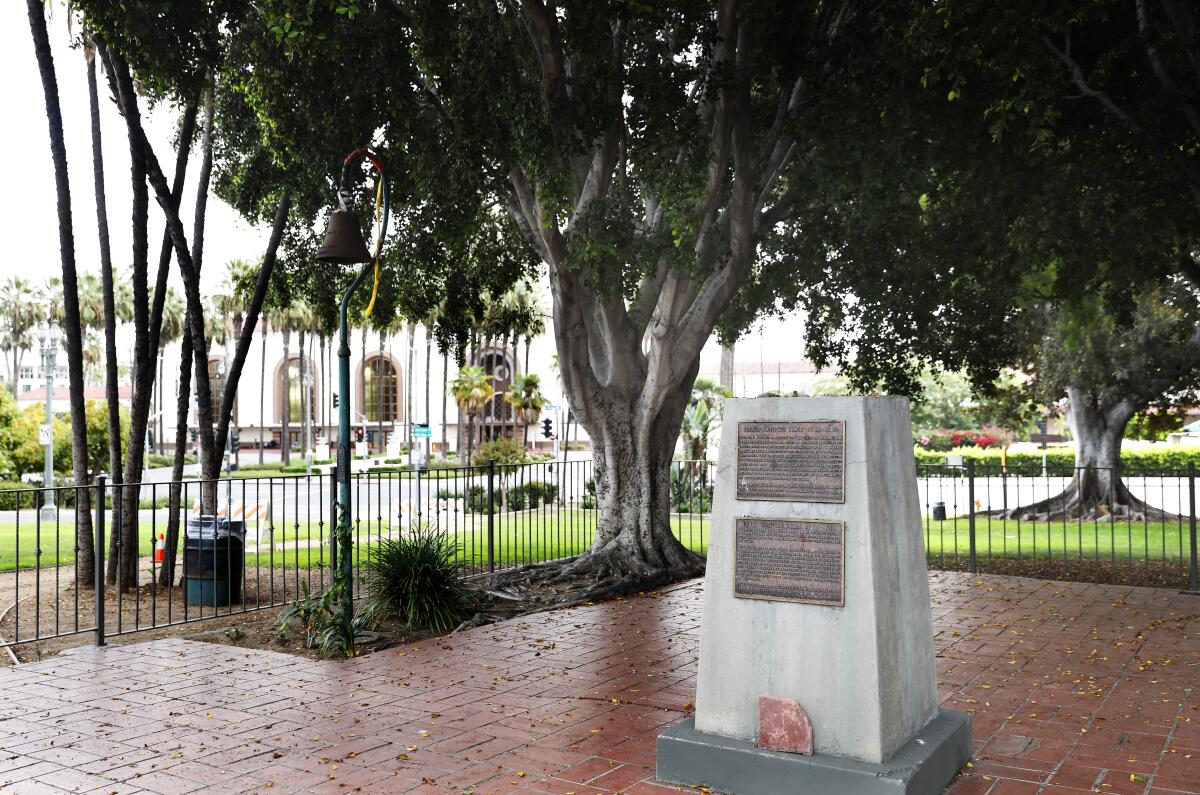
Plus, an interesting essay by filmmaker and writer Jason Asenap looks at how we are now experiencing a key moment for Indigenous criticism.
Essential happenings
It appears that everything is opening at once after two years of pandemic closures, but thankfully Matt Cooper is here to provide the essential rundown of what’s going down this weekend. It includes weekend concerts by the L.A. Phil at Disney Hall and a show of California photography at the Vincent Price Art Museum.
Cooper also rounds up the 13 best bets for Halloween fun, including events for kids and adults, in addition to a staging of “Tim Burton’s The Nightmare Before Christmas in Concert” with Danny Elfman and Billie Eilish.
In the event that you have serious FOMO over the premiere of Terence Blanchard’s “Fire Shut Up in My Bones” at New York’s Metropolitan Opera, you can always find Live in HD streamed screenings in theaters around Los Angeles (and beyond).
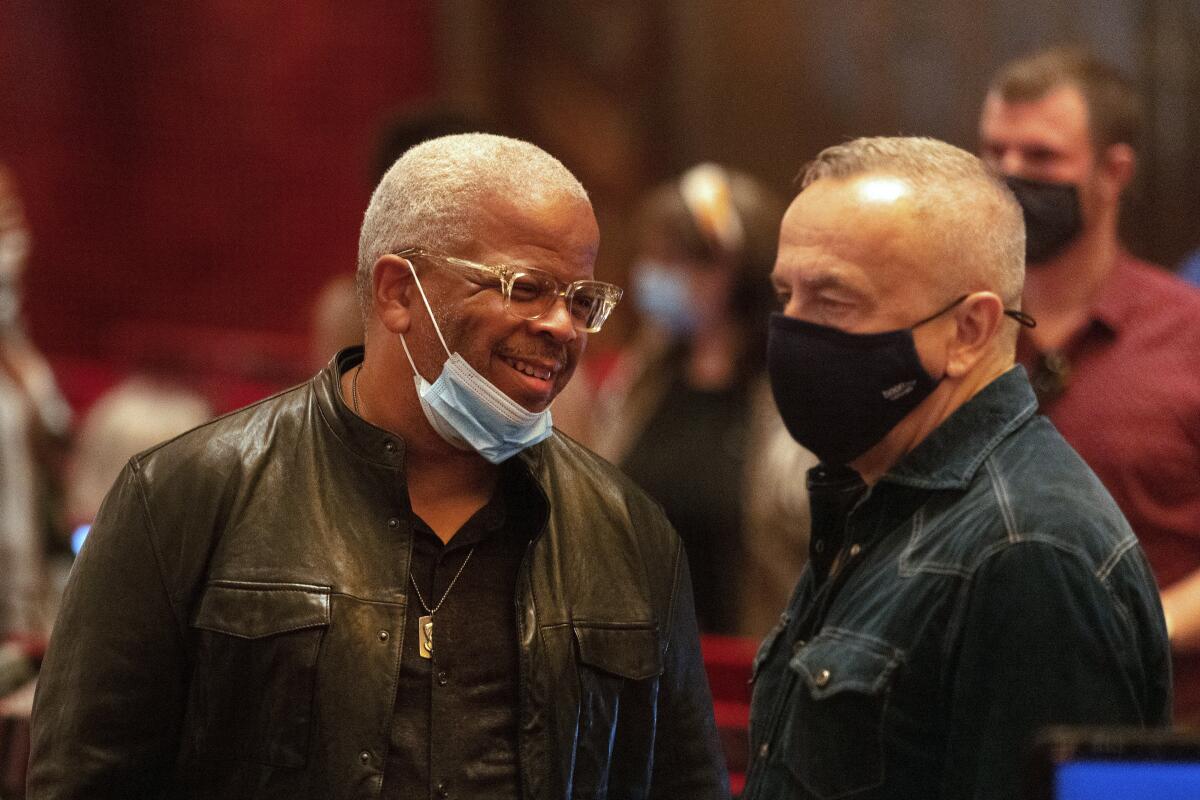
Passages
Margo Leavin, a Los Angeles gallerist who presented the work of key Southern California artists such as John Baldessari, Roy Dowell and Allen Ruppersberg, and who served as lead patron on the graduate studios at UCLA that bear her name, is dead at 85.
Architect Owen Luder, a British designer known for brutalist buildings such as the Trinity Square parking structure and the Tricorn Centre, has died at 93.
In other news
— “I haven’t practiced my violin since the day the Taliban came.” Only some members of Afghanistan’s all-female orchestra were able to escape before the fall of Kabul.
— Oakland painter Hung Liu, who died in August, is the subject of a new exhibition at the National Portrait Gallery, the first featuring an Asian American woman at the museum.
— A show of Joey Terrill’s paintings at Ortuzar Projects in New York is making me wish someone would stage this show in L.A.
— The Underground Museum has named Meg Onli and Cristina Pacheco co-directors.
— Virginia-based landscape architect Julie Bargmann, who has transformed toxic industrial sites into green spaces, has won the inaugural Cornelia Hahn Oberlander International Landscape Architecture Prize awarded by the Cultural Landscape Foundation.
— Sort of related: Eugenia C. South has an interesting essay about how cleaning up urban spaces and maintaining green spaces can help quell violent crime.
— Conor Dougherty looks at how California’s suburbs are being remade.
— New Angle: Voice, a new podcast by the Beverly Willis Architecture Foundation, will explore the work of women architects, and its first episode is devoted to architect Julia Morgan. This is a great overview of a figure who helped shape the landscape of California.
— Earlier this week I tweeted about the need for an essay about hair aesthetics in connection with the Elizabeth Holmes trial. (She has ditched her blowouts for soft curls.) It turns out that Sarah Mesle wrote a piece in the Los Angeles Review of Books back in January that serves as a pretty terrific dive into the narratives of hair.
— A new book examines the origins of hell. Believe it or not, it’s not the 405 at rush hour.
And last but not least ...
Take footage from the new sci-fi feature “Dune” and add a ballad by Vicente Fernández and what do you get? A telenovela.
The biggest entertainment stories
Get our big stories about Hollywood, film, television, music, arts, culture and more right in your inbox as soon as they publish.
You may occasionally receive promotional content from the Los Angeles Times.




